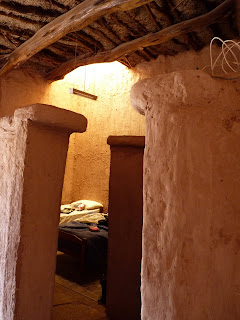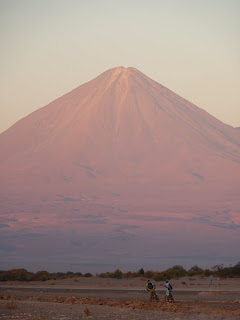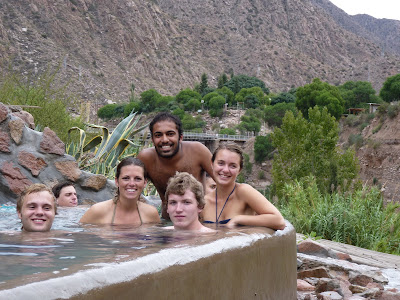The LPG's tiny section on SPA does the place scant justice, but that didn't stop it being (as always) the starting point following our arrival from the visual spectacular that is the Jujuy-SPA bus route. We decided to stay at Residencial Vilacoyo, which was (like basically every building in the village) adobe constructed and thus amazingly cool (in the thermal sense, for once) inside despite the pelting desert heat outdoors (see right). With a courtyard strewn with hammocks - the best things ever, as far as I'm concerned - it was a pretty good haunt.
As with pretty much every step of our travels, we don't really have any idea how long we were going to stay, but took on day one in typically cavalier attitude with plans to check out the "psychedelic" landscape around the village and generally scout some sights. Being the adventurous young firebrands that we apparently are, we're reluctant to just hop on a tour in order to see things... but with so much to see this provides an alternative counter-problem: deciding on what to do - especially given the time constraints - proves rather challenging.
Recommended by the LPG, and by the parts of our bodies craving exercise, we decided to rent a couple of mountain bikes for the afternoon, setting ourselves the aim of checking out the Pukará de Quitor en route to Quebrada del Diablo, before bossing about 15km back down the same gravel road in the opposite direction, past (which is basically the same as through when you're talking about SPA) the town, and down the highway to catch sunset in Valle de la Luna (Lunar Valley; named for good reason).
 The pukará itself (right) was similar in many ways to the one Tom and I tore up back in Chilcara, although getting to the top involved a much bigger climb and lacked the hundreds of here's-where-someone-had-a-dump-400-years-ago memorial cacti. However, what made this place poles apart was the view. The mesmerising mixture of colours, their shades and their depth, added what can only be described as a surreal hue to a scene that would blow off your socks in black and white alone. As illustrated:
The pukará itself (right) was similar in many ways to the one Tom and I tore up back in Chilcara, although getting to the top involved a much bigger climb and lacked the hundreds of here's-where-someone-had-a-dump-400-years-ago memorial cacti. However, what made this place poles apart was the view. The mesmerising mixture of colours, their shades and their depth, added what can only be described as a surreal hue to a scene that would blow off your socks in black and white alone. As illustrated:Armed with a map that we later discovered had north pointing south-west (and thus explained why the old sense of direction was going haywire everywhere we went), we headed onward down the dirt track a further 3km from the pukará, through a colourful floodplain flanked by rugged red hills (right) en route to Quebrada del Diablo (the "Devil's Gorge"). Obstacles along the way, aside from the dodgy map, included the bludgeoning early afternoon heat, and a fairly significant river that we had to cross to continue down the path. I'm all for maintaining the cavalier attitude when it comes to these sort of things, but as it rather wetly transpired, you couldn't simply "power through".
Into the quebrada itself, however, and you soon forget where you've just been. As if carved by a rather skilled labyrinth-architect, the gorge traverses a seemingly never-ended serpentine path through the middle of the towering rock that borders the valley - each corner you round producing ever more spectacular sights. The geographers in our Juddian crew back home would (presumably) have gone to town over the geological formations on display, but the real story was how bloody awesome a bike track this place was - a true challenge at high speed, weaving left-right-left-right through blind corners on a surface that varied from dirt to thick sand. And wasn't half bad to look at either:
We eventually decided we had no idea how long and deep into the rocks the path would go - it didn't seem to ever end - and wanted to crack on into order to get to the Lunar Valley, on the other side of SPA, in time for sunset. I think it basically came down to needed to cover 20km in an hour; a feat much easier said than done on mountain bikes and dirt tracks in desert heat; but off we went anyway, past the pukará, in and out of the edge of SPA, and off on a big, bad, tarmac highway towards a direction that our map would suggest was south-east, but conventional bearings would better describe as due west.
It doesn't take a genius to explain the name - the barren expanse of land in the Valle de la Luna resembles that of the Moon. Sadly, the best example of this is a further 7km from the entrance to the national park grounds - a distance we were never going to cover in the 15-20mins till sunset, and barely had the energy to do anyway. So we did the clever thing and cut our losses, chillaxed with some soft drinks, and used our shit hot cameras to gets some cool photography. And then cycled all the way back to SPA in the cold and dark with hunger welling up in inside of me like magma inside Vesuvius circa AD79. Your standard day of travels, basically.




















































